Microstructure of In-Situ Friction Stir Processed Al-Cu Transition Zone
Abstract
1. Introduction
2. Materials and Methods
3. Results
4. Discussion
5. Conclusions
- The single-pass FSP on Cu-Al bimetal plate resulted in the formation of a stir zone with inhomogeneous distribution of intermixed phases identified as unreacted metals, intermetallic phases such as Al2Cu, Al2Cu3, AlCu3, Al2MgCu, Al(Mg,Cu) solid solution and Al-Al2Cu eutectics.
- Large IMC particles as well as Al-Al2Cu eutectics and Al-Mg-Cu solid solution dendrites were preferentially located on the advancing side of the SZ zone, while the retreating side zone of SZ was characterized by the presence of Al-Cu solid solution layered structures and smaller IMC particles located between the solid solution layers.
- The microhardness profiles measured across the SZ digitally mirrors the inhomogeneity of the phase distribution there. The microhardness of IMC zones is by a factor of 2–5 higher than that of copper.
- The IMC areas containing the eutectics and solid solution dendrites, which might originate from Al-Cu liquation, are characterized by large irregular shaped shrinkage pores.
Author Contributions
Funding
Conflicts of Interest
References
- Sudhakar, M.; Rao, C.H.S.; Saheb, K.M. Production of Surface Composites by Friction Stir Processing-A Review. Mater. Today Proc. 2018, 5, 929–935. [Google Scholar] [CrossRef]
- Padhy, G.K.; Wu, C.S.; Gao, S. Friction stir based welding and processing technologies-processes, parameters, microstructures and applications: A review. J. Mater. Sci. Technol. 2018, 34, 1–38. [Google Scholar] [CrossRef]
- Rao, A.G.; Ravi, K.R.; Ramakrishnarao, B.; Deshmukh, V.P.; Sharma, A.; Prabhu, N.; Kashyap, B.P. Recrystallization Phenomena During Friction Stir Processing of Hypereutectic Aluminum-Silicon Alloy. Metall. Mater. Trans. A 2013, 44, 1519–1529. [Google Scholar] [CrossRef]
- Sun, H.; Yang, S.; Jin, D. Improvement of Microstructure, Mechanical Properties and Corrosion Resistance of Cast Al--12Si Alloy by Friction Stir Processing. Trans. Indian Inst. Met. 2018, 71, 985–991. [Google Scholar] [CrossRef]
- Zhao, H.; Pan, Q.; Qin, Q.; Wu, Y.; Su, X. Effect of the processing parameters of friction stir processing on the microstructure and mechanical properties of 6063 aluminum alloy. Mater. Sci. Eng. A 2019, 751, 70–79. [Google Scholar] [CrossRef]
- Zahmatkesh, B.; Enayati, M.H. A novel approach for development of surface nanocomposite by friction stir processing. Mater. Sci. Eng. A 2010, 527, 6734–6740. [Google Scholar] [CrossRef]
- Bourkhani, R.D.; Eivani, A.R.; Nateghi, H.R. Through-thickness inhomogeneity in microstructure and tensile properties and tribological performance of friction stir processed AA1050-Al2O3 nanocomposite. Compos. Part B Eng. 2019, 174, 107061. [Google Scholar] [CrossRef]
- Abraham, S.J.; Dinaharan, I.; Selvam, J.D.R.; Akinlabi, E.T. Microstructural characterization of vanadium particles reinforced AA6063 aluminum matrix composites via friction stir processing with improved tensile strength and appreciable ductility. Compos. Commun. 2019, 12, 54–58. [Google Scholar] [CrossRef]
- Jain, V.K.S.; Varghese, J.; Muthukumaran, S. Effect of First and Second Passes on Microstructure and Wear Properties of Titanium Dioxide-Reinforced Aluminum Surface Composite via Friction Stir Processing. Arab. J. Sci. Eng. 2019, 44, 949–957. [Google Scholar] [CrossRef]
- Huang, C.W.; Aoh, J.N. Friction stir processing of copper-coated SiC particulate-reinforced aluminum matrix composite. Materials (Basel) 2018, 11, 599. [Google Scholar] [CrossRef]
- Prabhu, M.S.; Perumal, A.E.; Arulvel, S.; Issac, R.F. Friction and wear measurements of friction stir processed aluminium alloy 6082/CaCO3 composite. Measurement 2019, 142, 10–20. [Google Scholar] [CrossRef]
- Barati, M.; Abbasi, M.; Abedini, M. The effects of friction stir processing and friction stir vibration processing on mechanical, wear and corrosion characteristics of Al6061/SiO2 surface composite. J. Manuf. Process. 2019, 45, 491–497. [Google Scholar] [CrossRef]
- Nazari, M.; Eskandari, H.; Khodabakhshi, F. Production and characterization of an advanced AA6061-Graphene-TiB2 hybrid surface nanocomposite by multi-pass friction stir processing. Surf. Coatings Technol. 2019, 377, 124914. [Google Scholar] [CrossRef]
- Adetunla, A.; Akinlabi, E. Fabrication of Aluminum Matrix Composites for Automotive Industry Via Multipass Friction Stir Processing Technique. Int. J. Automot. Technol. 2019, 20, 1079–1088. [Google Scholar] [CrossRef]
- Fotoohi, H.; Lotfi, B.; Sadeghian, Z.; Byeon, J. Microstructural characterization and properties of in situ Al-Al3Ni/TiC hybrid composite fabricated by friction stir processing using reactive powder. Mater. Charact. 2019, 149, 124–132. [Google Scholar] [CrossRef]
- Mahmoud, E.R.I.; Al-qozaim, A.M.A. Fabrication of In-Situ Al-Cu Intermetallics on Aluminum Surface by Friction Stir Processing. Arab. J. Sci. Eng. 2016, 41, 1757–1769. [Google Scholar] [CrossRef]
- Azimi-Roeen, G.; Kashani-Bozorg, S.F.; Nosko, M.; Nagy, Š.; Ma\vTko, I. Correction to: Formation of Al/(Al13Fe4 + Al2O3) Nano-composites via Mechanical Alloying and Friction Stir Processing. J. Mater. Eng. Perform. 2018, 27, 6800. [Google Scholar] [CrossRef]
- Dinaharan, I.; Akinlabi, E.T. Low cost metal matrix composites based on aluminum, magnesium and copper reinforced with fly ash prepared using friction stir processing. Compos. Commun. 2018, 9, 22–26. [Google Scholar] [CrossRef]
- Kumar, P.A.; Madhu, H.C.; Pariyar, A.; Perugu, C.S.; Kailas, S.V.; Garg, U.; Rohatgi, P. Friction stir processing of squeeze cast A356 with surface compacted graphene nanoplatelets (GNPs) for the synthesis of metal matrix composites. Mater. Sci. Eng. A 2020, 769, 138517. [Google Scholar] [CrossRef]
- Zhang, Q.; Xiao, B.L.; Wang, Q.Z.; Ma, Z.Y. In situ Al3Ti and Al2O3 nanoparticles reinforced Al composites produced by friction stir processing in an Al-TiO2 system. Mater. Lett. 2011, 65, 2070–2072. [Google Scholar] [CrossRef]
- Alidokht, S.A.; Abdollah-zadeh, A.; Soleymani, S.; Assadi, H. Microstructure and tribological performance of an aluminium alloy based hybrid composite produced by friction stir processing. Mater. Des. 2011, 32, 2727–2733. [Google Scholar] [CrossRef]
- Zeidabadi, S.R.H.; Daneshmanesh, H. Fabrication and characterization of in-situ Al/Nb metal/intermetallic surface composite by friction stir processing. Mater. Sci. Eng. A 2017, 702, 189–195. [Google Scholar] [CrossRef]
- Ponweiser, N.; Lengauer, C.L.; Richter, K.W. Re-investigation of phase equilibria in the system Al–Cu and structural analysis of the high-temperature phase η1-Al1−δCu. Intermetallics 2011, 19, 1737–1746. [Google Scholar] [CrossRef]
- Zhou, L.; Zhang, R.X.; Li, G.H.; Zhou, W.L.; Huang, Y.X.; Song, X.G. Effect of pin profile on microstructure and mechanical properties of friction stir spot welded Al-Cu dissimilar metals. J. Manuf. Process. 2018, 36, 1–9. [Google Scholar] [CrossRef]
- Shankar, S.; Vilaça, P.; Dash, P.; Chattopadhyaya, S.; Hloch, S. Joint strength evaluation of friction stir welded Al-Cu dissimilar alloys. Measurement 2019, 146, 892–902. [Google Scholar] [CrossRef]
- Khojastehnezhad, V.M.; Pourasl, H.H. Microstructural characterization and mechanical properties of aluminum 6061-T6 plates welded with copper insert plate (Al/Cu/Al) using friction stir welding. Trans. Nonferrous Met. Soc. China 2018, 28, 415–426. [Google Scholar] [CrossRef]
- Xue, P.; Xiao, B.L.; Ni, D.R.; Ma, Z.Y. Enhanced mechanical properties of friction stir welded dissimilar Al–Cu joint by intermetallic compounds. Mater. Sci. Eng. A 2010, 527, 5723–5727. [Google Scholar] [CrossRef]
- Zhang, G.; Yang, X.; Zhu, D.; Zhang, L. Cladding thick Al plate onto strong steel substrate using a novel process of multilayer-friction stir brazing (ML-FSB). Mater. Des. 2020, 185, 108232. [Google Scholar] [CrossRef]
- Muhammad, N.A.; Wu, C.S.; Tian, W. Effect of ultrasonic vibration on the intermetallic compound layer formation in Al/Cu friction stir weld joints. J. Alloys Compd. 2019, 785, 512–522. [Google Scholar] [CrossRef]
- Hsu, C.J.; Kao, P.W.; Ho, N.J. Ultrafine-grained Al–Al2Cu composite produced in situ by friction stir processing. Scr. Mater. 2005, 53, 341–345. [Google Scholar] [CrossRef]
- Huang, G.; Hou, W.; Li, J.; Shen, Y. Development of surface composite based on Al-Cu system by friction stir processing: Evaluation of microstructure, formation mechanism and wear behavior. Surf. Coatings Technol. 2018, 344, 30–42. [Google Scholar] [CrossRef]
- Kalashnikova, T.A.; Gusarova, A.V.; Chumaevskii, A.V.; Knyazhev, E.O.; Shvedov, M.A.; Vasilyev, P.A. Regularities of composite materials formation using additive electron-beam technology, friction stir welding and friction stir processing. Metall. Work. Mater. Sci. 2016, 63, 2016. (In Russian) [Google Scholar] [CrossRef]
- Pretorius, R.; Marais, T.K.; Theron, C.C. Thin film compound phase formation sequence: An effective heat of formation model. Mater. Sci. Rep. 1993, 10, 1–83. [Google Scholar] [CrossRef]
- Azizie, H.M.; Iranparast, D.; Dezfuli, M.A.G.; Balak, Z.; Kim, H.S. Fabrication of Al/Al2Cu in situ nanocomposite via friction stir processing. Trans. Nonferrous Met. Soc. China 2017, 27, 779–788. [Google Scholar] [CrossRef]
- Yang, L.; Mi, B.X.; Lv, L.; Huang, H.J.; Lin, X.P.; Yuan, X.G. Formation Sequence of Interface Intermetallic Phases of Cold Rolling Cu/Al Clad Metal Sheet in Annealing Process. Mater. Sci. Forum 2013, 749, 600–605. [Google Scholar] [CrossRef]
- Shen, J.; Suhuddin, U.F.H.; Cardillo, M.E.B.; dos Santos, J.F. Eutectic structures in friction spot welding joint of aluminum alloy to copper. Appl. Phys. Lett. 2014, 104, 191901. [Google Scholar] [CrossRef]
- Tarasov, S.Y.; Filippov, A.V.; Kolubaev, E.A.; Kalashnikova, T.A. Adhesion transfer in sliding a steel ball against an aluminum alloy. Tribol. Int. 2017, 115, 191–198. [Google Scholar] [CrossRef]
- Hersent, E.; Driver, J.H.; Piot, D.; Desrayaud, C. Integrated modelling of precipitation during friction stir welding of 2024-T3 aluminum alloy. Mater. Sci. Technol. 2010, 26, 1345–1352. [Google Scholar] [CrossRef]
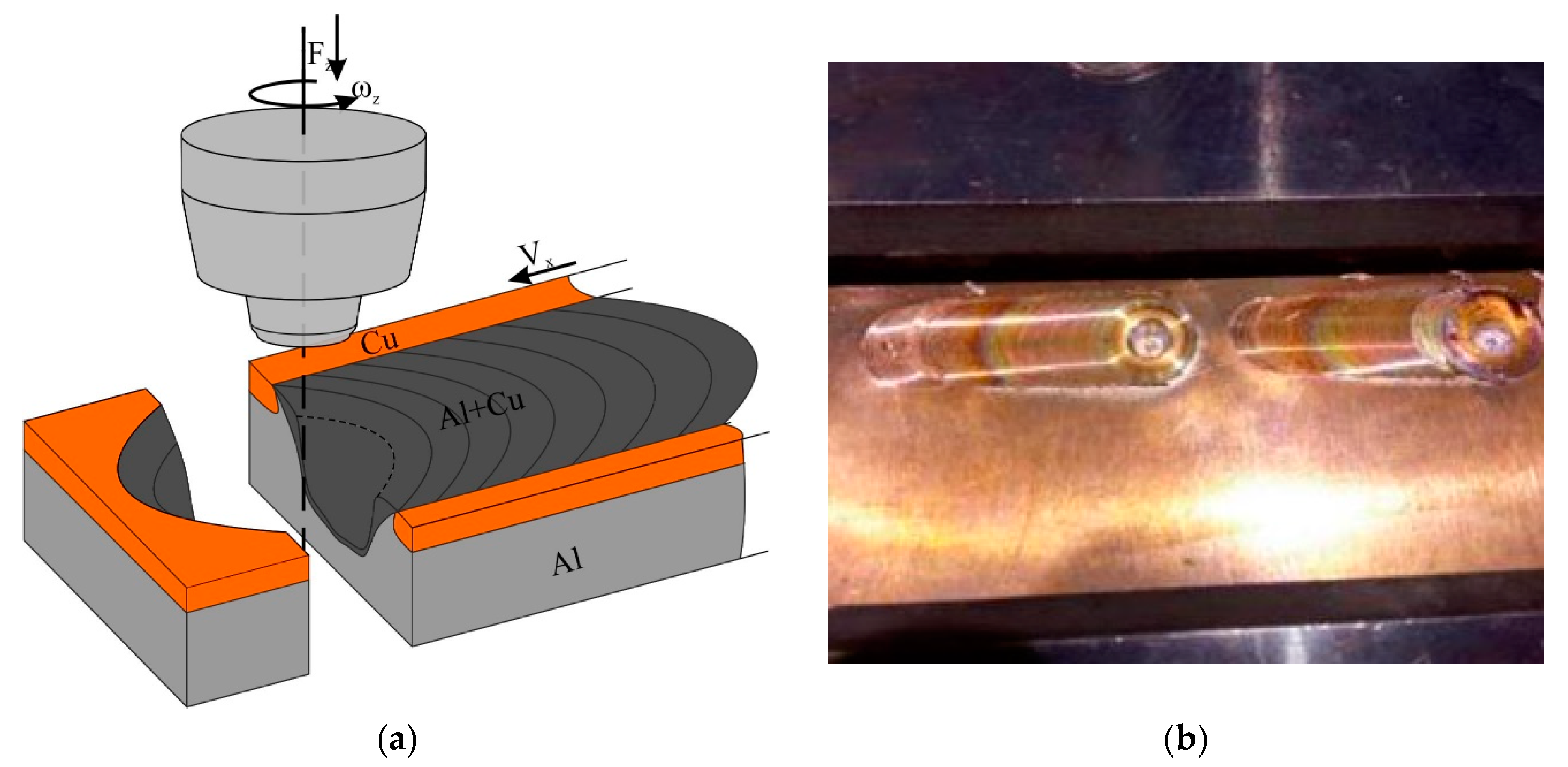
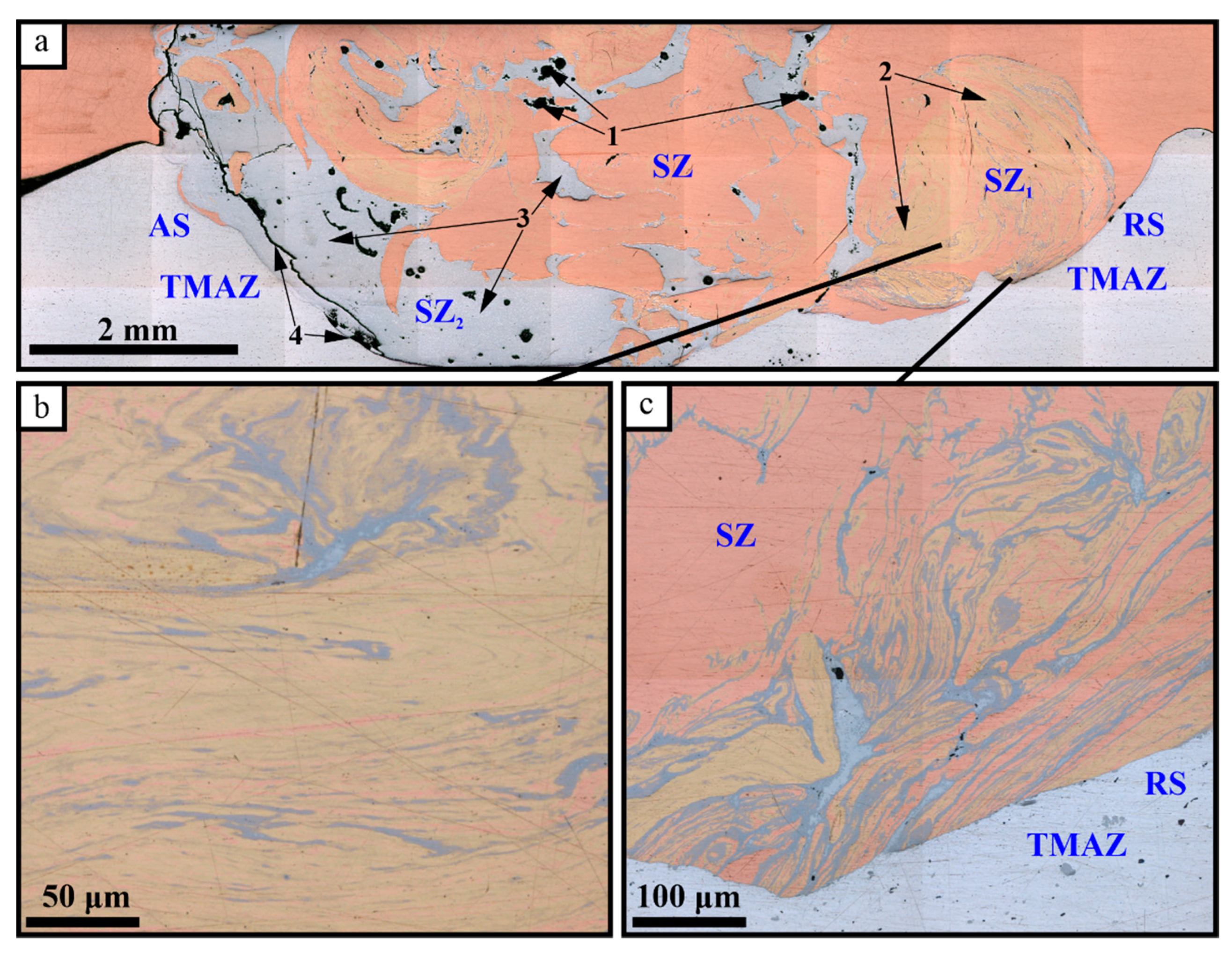
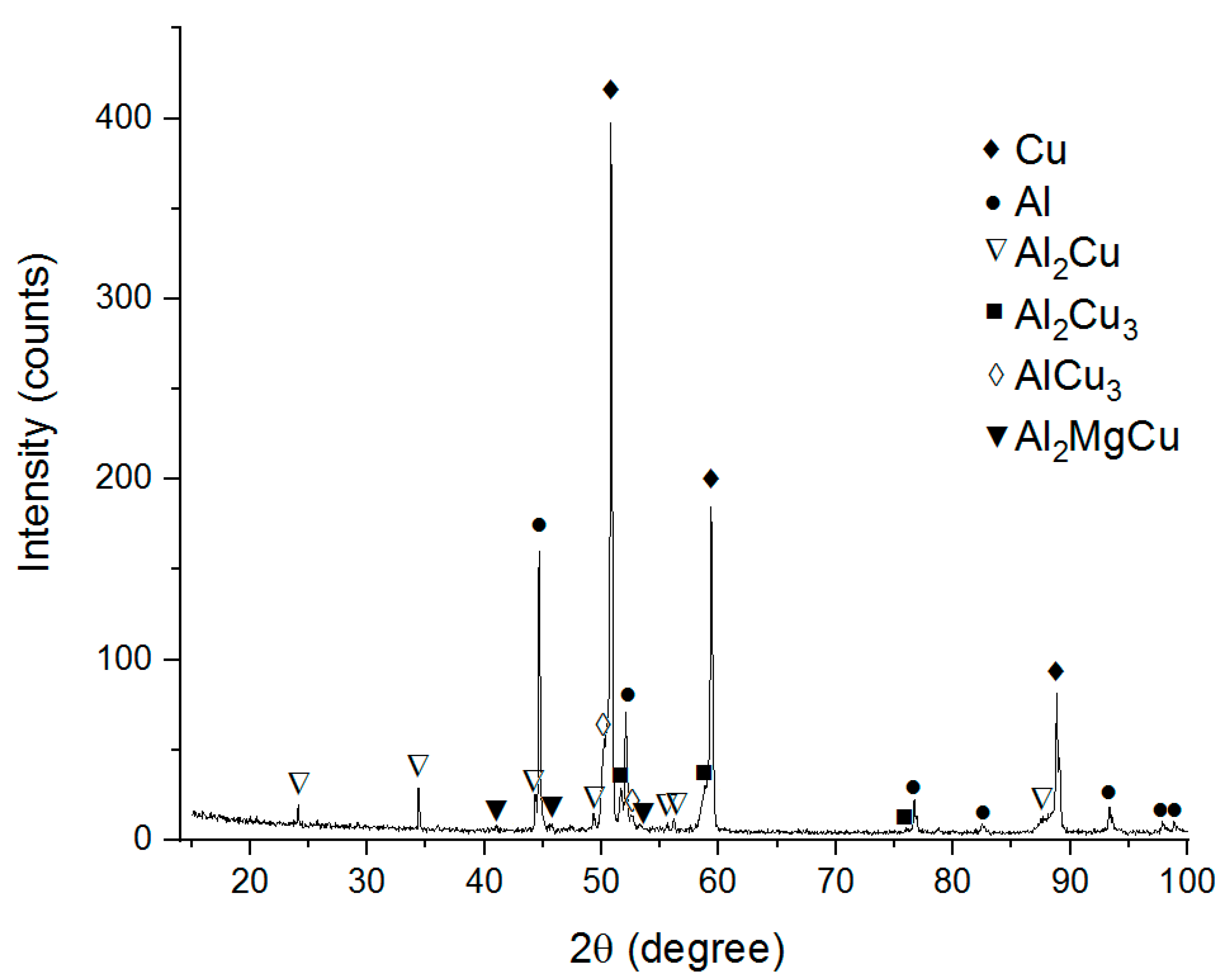


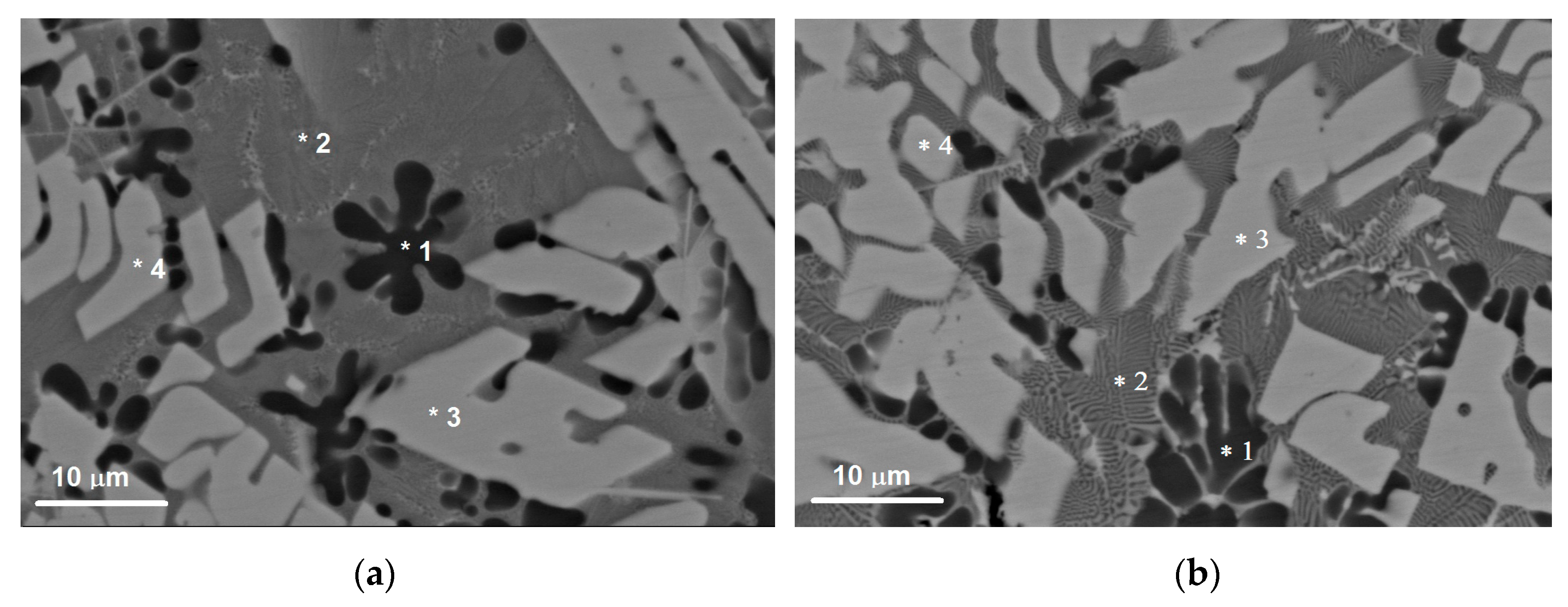
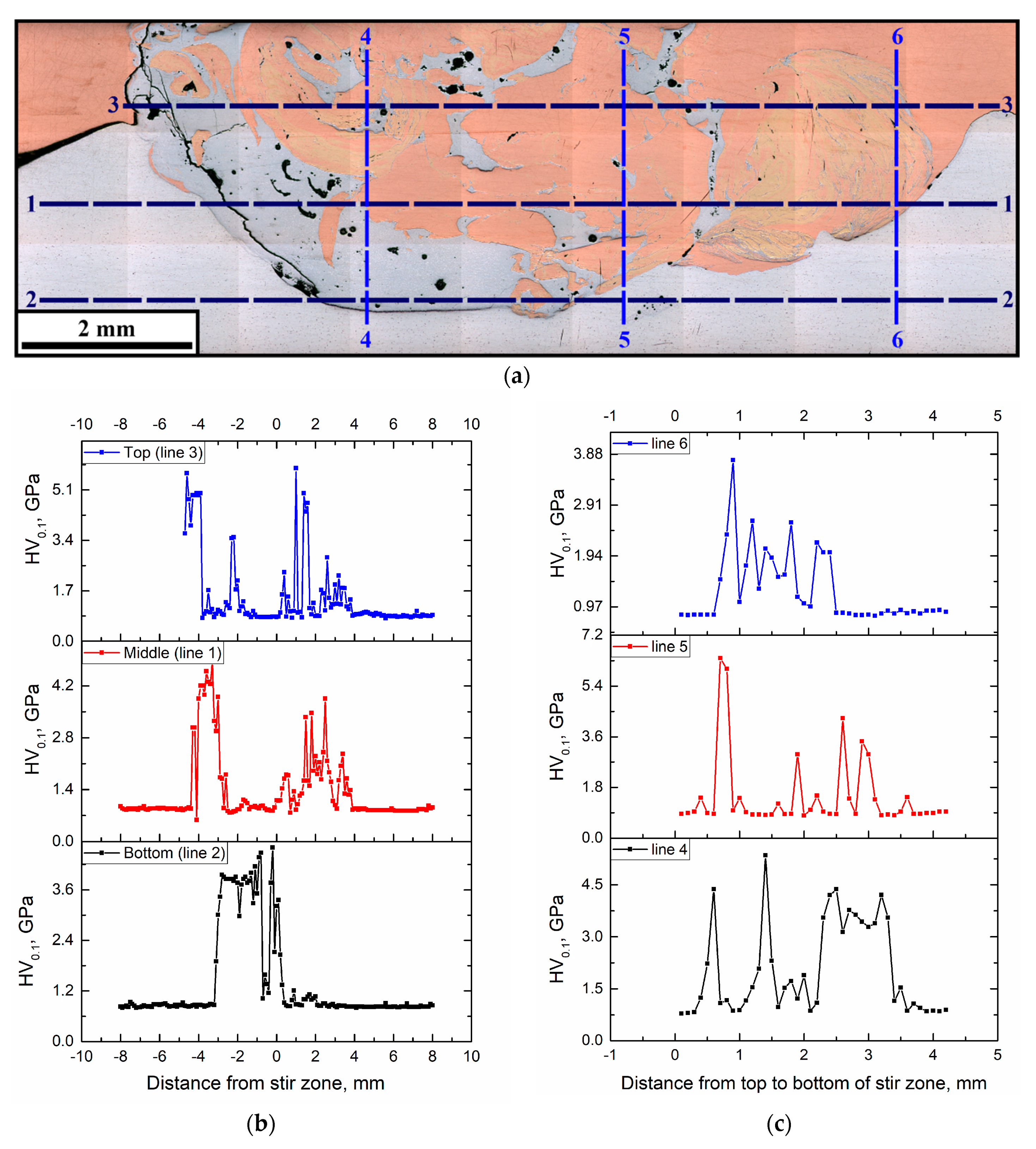
| Plates | Chemical Element, wt.%. | ||||||||||
|---|---|---|---|---|---|---|---|---|---|---|---|
| Al | Mg | Fe | Si | Mn | Cu | Zn | Ti | Ni | Pb | As | |
| A5056 | 91.9–94.6 | 4.8–5.8 | <0.5 | <0.5 | 0.5–0.8 | <0.1 | <0.2 | <0.02–0.1 | - | - | - |
| C11000 | - | - | <0.005 | - | - | 99.9 | <0.004 | - | <0.002 | <0.005 | <0.002 |
| No. | Element | Content, at.% | Phase Formula | Morphology |
|---|---|---|---|---|
| 1 | Al | 69.8 | Al2Cu | Near-spherical |
| Cu | 30.2 | |||
| 2 | Al | 71.3 | Al2Cu | rectangular |
| Cu | 28.7 | |||
| 3 | Al | 72.9 | Al2Cu | plate |
| Cu | 27.1 | |||
| 4 | Al | 46.6 | Al2Cu3 | irregular |
| Cu | 53.4 | |||
| 5 | Al | 36.4 | AlCu3 | irregular |
| Cu | 63.6 | |||
| 6 | Al | 36.8 | AlCu3 | irregular |
| Cu | 63.2 | |||
| 7 | Al | 39.2 | Al2Cu3 | irregular |
| Cu | 60.8 | |||
| 8 | Mg | 9.4 | AlMg/ Al2Cu | eutectics |
| Al | 80.0 | |||
| Cu | 10.6 | |||
| 9 | Mg | 26.0 | AlMg/ Al2Cu | eutectics |
| Al | 50.6 | |||
| Cu | 23.4 | |||
| 10 | Mg | 14.6 | AlMg/ Al2Cu | eutectics |
| Al | 49.2 | |||
| Cu | 36.2 | |||
| 11 | Al | 68.7 | Al2Cu | equiaxial |
| Cu | 31.3 | |||
| 12 | Al | 68.7 | Al2Cu | equiaxial |
| Cu | 31.3 | |||
| 13 | Al | 63.8 | Al2Cu | spherical |
| Cu | 36.2 | |||
| 14 | Mg | 16.6 | Al2MgCu | eutectics |
| Al | 67.4 | |||
| Cu | 16.0 | |||
| 15 | Mg | 6.8 | AlMg/ Al2Cu | eutectics |
| Al | 83.6 | |||
| Cu | 9.6 | |||
| 16 | Mg | 4.3 | AlMg/ Al2Cu | eutectics |
| Al | 88.9 | |||
| Cu | 6.8 |
| Spectrum | Element | Content, at.% | Phase Formula | Morphology |
|---|---|---|---|---|
| 1 (Figure 6a) | Al | 93.7 | Al(Cu,Mg) | dendritic |
| Cu | 4.0 | |||
| Mg | 2.3 | |||
| 2 (Figure 6a) | Al | 66.8 | AlMg/ Al2Cu | eutectics |
| Cu | 20.4 | |||
| Mg | 12.8 | |||
| 3 (Figure 6a) | Al | 62.9 | Al2Cu | rectangular |
| Cu | 35.7 | |||
| Mg | 1.4 | |||
| 4 (Figure 6a) | Al | 61.6 | Al2Cu | angularity |
| Cu | 37.5 | |||
| Mg | 0.9 | |||
| 1 (Figure 6b) | Al | 91.2 | Al(Cu,Mg) | dendritic |
| Cu | 5.7 | |||
| Mg | 3.1 | |||
| 2 (Figure 6b) | Al | 71.9 | AlMg/ Al2Cu | eutectics |
| Cu | 15.8 | |||
| Mg | 12.3 | |||
| 3 (Figure 6b) | Al | 63.6 | Al2Cu | angularity |
| Cu | 35.5 | |||
| Mg | 0.9 | |||
| 4 (Figure 6b) | Al | 66.0 | Al2Cu | angularity |
| Cu | 31.9 | |||
| Mg | 2.1 |
| IMC | Composition | Limiting Element | [35], J/mol | at 450 °C, kJ/mol | , kJ/mol |
|---|---|---|---|---|---|
| Al2Cu | Al0.67Cu0.33 | Al | −15,826.2 + 2.3T | −14.16 | −19.54 |
| AlCu | Al0.50Cu0.50 | Al(Cu) | −20,496.8 + 1.6T | −19.34 | −19.34 |
| Al3Cu4 | Al0.43Cu0.57 | Cu | −20,197.4 + 1.9T | −18.82 | −18.82 |
| Al2Cu3 | Al0.40Cu0.60 | Al | −20,137.8 + 1.6T | −18.98 | −31.28 |
| Al4Cu9 | Al0.31Cu0.69 | Cu | −19,707.1 + 1.6T | −18.55 | −18.55 |
| AlCu3 | Al0.25Cu0.75 | Al | −19,146.8 + 1.6T | −17.99 | −22.84 |
© 2020 by the authors. Licensee MDPI, Basel, Switzerland. This article is an open access article distributed under the terms and conditions of the Creative Commons Attribution (CC BY) license (http://creativecommons.org/licenses/by/4.0/).
Share and Cite
Zykova, A.; Chumaevskii, A.; Gusarova, A.; Kalashnikova, T.; Fortuna, S.; Savchenko, N.; Kolubaev, E.; Tarasov, S. Microstructure of In-Situ Friction Stir Processed Al-Cu Transition Zone. Metals 2020, 10, 818. https://doi.org/10.3390/met10060818
Zykova A, Chumaevskii A, Gusarova A, Kalashnikova T, Fortuna S, Savchenko N, Kolubaev E, Tarasov S. Microstructure of In-Situ Friction Stir Processed Al-Cu Transition Zone. Metals. 2020; 10(6):818. https://doi.org/10.3390/met10060818
Chicago/Turabian StyleZykova, Anna, Andrey Chumaevskii, Anastasia Gusarova, Tatiana Kalashnikova, Sergei Fortuna, Nickolai Savchenko, Evgeny Kolubaev, and Sergei Tarasov. 2020. "Microstructure of In-Situ Friction Stir Processed Al-Cu Transition Zone" Metals 10, no. 6: 818. https://doi.org/10.3390/met10060818
APA StyleZykova, A., Chumaevskii, A., Gusarova, A., Kalashnikova, T., Fortuna, S., Savchenko, N., Kolubaev, E., & Tarasov, S. (2020). Microstructure of In-Situ Friction Stir Processed Al-Cu Transition Zone. Metals, 10(6), 818. https://doi.org/10.3390/met10060818








